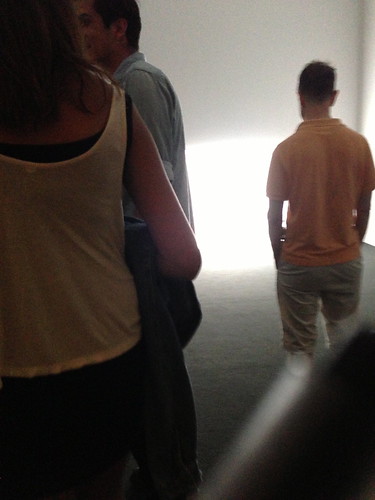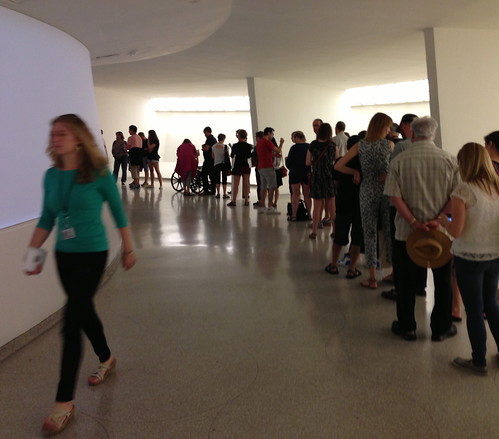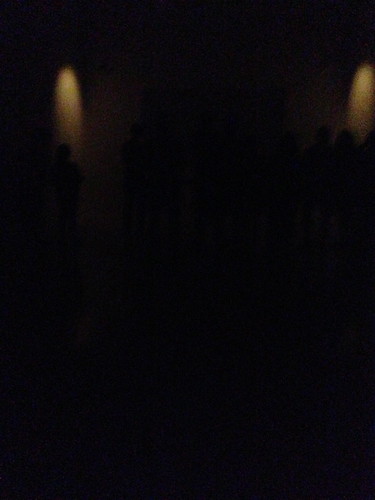I did not see nor wait in line for the
Metropolitan Museum of Art's "Rain Room" (nor have I queued up, beginning at 5:30 am, for a cronut--
yet), so I cannot say definitively that
James Turrell's (1934-) exhibition at the
Guggenheim Museum is the most crowd-pleasing New York City art show of the summer, but I won't hesitate to urge anyone who is in anywhere near upper Manhattan, has a few hours, and wants to be delighted and lulled by Turrell's artistry to catch the show.
 |
| Afrum I (White), 1967 (iPhone drawing by John Keene) |
 |
Ronin (1968), Fluorescent light,
dimensions variable
© James Turrell / Photo: Courtesy the Stedelijk Museum |
Running until September 25, and James Turrell's first exhibition since 1980 in a New York City museum, the show gathers together several differing and compelling examples of this artist's work, which employs and explores light, color, space, and the possibilities human perception. The show-stopper, which I had heard people rave about and thus had to experience firsthand, is
Aten Reign (2013), his transformation of the Guggenheim's rotunda into a sublime oculus that fills and shifts with natural and artificial light depending upon the position of the sun and time of day, the weather, and perhaps other mechanisms I'm unaware of. When I entered the museum, the rotunda was a pale yellow, and I thought, pretty but ho hum, certainly an accomplishment but not worthy of all the hullabaloo. I preceded up the spiral to view the smaller light displays in the Annex-level galleries, about which I'll say a little more below, and was impressed, though the long line to see the topmost piece, a bit of a dud that plays deeply with one's sense of space and vision, did peeve me. I returned downstairs and decided to stand at the periphery of the oculus and draw it, since photography was forbidden. (I had been drawing in my sketchbook, so I decided to see if I could get away with using my phone.)
 |
| Aten Reign, 2013 (iPhone drawing by John Keene) |
 |
Rendering for Aten Reign (2013), Daylight and
LED light, © James Turrell / Rendering: Andreas Tjeldflaat,
2012 © Solomon R. Guggenheim Foundation |
As one of Turrell's famous Skypaces--and evocative in particular of his
Roden Crater Project (1979-, the cinder cone crater he has remade in
Flagstaff, Arizona), and of
Meeting (1986), at New York's
P.S. 1--
Aten Reign demonstrates his sense of how to use light as a painterly and sculptural tool and device, in order to transform sensory perception. The rain clouds, which necessitated an umbrella, and late afternoon hour paid off, because by the time I had reached the rotunda it was beginning to dramatically and rapidly shift. Green, orange, yellow, and my favorite, an almost unbearably exquisite lavender that held for several minutes, before giving way to a tranquil, transcendent blue. I wanted to lie down on the mat that had been placed in the center of the floor to peer up at it, but there were no openings and none of the people there in deep thrall to the beautiful dance of light and hue appeared willing to move (I later read that the guards did cycle people in and out), so I walked around the periphery, drawing, staring up, in a reverie, just watching the unpredictable palette, until I decided to depart.
 |
| Prado (White), 1967 |
Curated by
Carmen Giménez, Stephen and Nan Swid Curator of Twentieth-Century Art, and
Nat Trotman, Associate Curator, Solomon R. Guggenheim Museum, and organized in conjunction with the
Los Angeles County Museum of Art (LACMA) and the
Museum of Fine Arts, Houston, the show also included wall-sized backlighted pieces (
Ronin, 1968) and projected light works:
Afrum I (White), 1967) and
Prado (White), 1967. There was only one real line to view one of the artworks, and it was a
very long one, the line, that is, not the artwork, that stretched halfway up the final summit of the Guggenheim's spiral, and took about 45 minutes to get through (I stood for a longer period to see
Christian Marclay's
The Clock, but the payoff was huge), to see
Iltar, 1976, an example of one of Turrell's
Ganzfeld works, in which a volume of light exists without discernable limits and boundaries, and can produce equally accurate perceptions and interpretations of reality. In the
Iltar room, which was divided, museum visitors stood in one space and encountered a "sensing space," a room or space that gathered its light energy from another area. In the case of
Iltar, the effect was akin to peering into what looked like a cloud--only there was nothing there, no mist, no real light, only the production of an effect based on a structural device Turrell had created. It was intriguing, but ultimately, I thought, not worth the wait. Perhaps a smaller space--a gallery or several?--will host Turrell exhibits comprising a series of
Ganzfelde--but make sure they're available for visitation for much greater hours than was the case to see
Iltar.
 |
| The line to see Turrell's Iltar (1976) |
 |
| The line to see Turrell's Iltar (1976) |
Ultimately
Aten Reign is worth the price of admission, or at least doesn't make shelling out $20 or so dollars that bad (though catch it on the Guggenheim's free day/night or use a student/elderly pass if you have one). And if you have to muscle--er, politely request that someone lift herself or himself off that circular pad so that you have an opportunity to stare up at the lightshow, well...I'm not counseling aggressive behavior, but when in Rome....
 |
| The entrance to Iltar (1976) |
 |
Iltar (1976), Tungsten light, dimensions variable
© James Turrell / Photo: Courtesy James Turrell |


















No comments:
Post a Comment